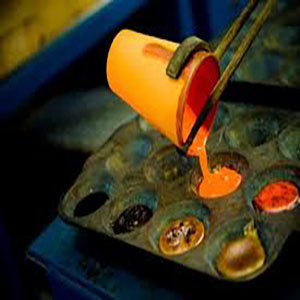Chemistry Lab
The chemistry laboratory of IMPRC, carries out elemental analysis on samples of geochemical explorations; and on high-grade, low-grade, and rare earths samples and so on. For this purpose, standard methods and high technology analytical equipment such as ICP-OES, ICP-MS, XRF, AAS, CS analyzer are used. Moreover, classical analysis is performed by using appropriate tools such as automatic titrator. For sample preparation, appropriate methods and equipment have been employed to perform drying, crushing, pulverization, fire assay, acid digestion, and alkali fusion.
 Sample preparation
Sample preparation  ICP-OES analysis
ICP-OES analysis  ICP-MS analysis
ICP-MS analysis  AAS analysis
AAS analysis  XRF analysis
XRF analysis  Carbon and sulfur analysis
Carbon and sulfur analysis  Fire assay
Fire assay  Wet chemistry analysis
Wet chemistry analysis
To obtain samples with proper homogeneity and mesh size, sample preparation processes are carried out by using avons, jaw crushers, roller crushers, pulverizers, etc. to perform drying, crushing, splitting and pulverizing of samples. In the next step, alkali fusion or/and acid digestion methods are used for the dissolution of powdered samples. Finally, the liquid samples are introduced into ICP or AAS instruments.
This spectroscopy method is based on the atomic emission in which argon plasma is used to produce exited atoms. The chemistry laboratory is equipped with state-of-the-art ICP-OES instrumentation that can capture both the axial and radial views of plasma in one reading, which produces accurate results with low detection limits (ppm for solid and ppb for liquid samples) in the quickest time. This advanced technique is used for determination of elemental concentrations in soil, water, rock, sediments, etc., which are important in environmental studies, geology and mineral processing.
Our ICP-MS analytical service can perform precise and accurate multi-element analysis at ppb levels. The instrument provides effective helium collision mode to control and reduce poly-atomic interference.
The Atomic Absorption Spectroscopy (AAS) is employed to determine the concentrations of metallic elements, specially Cu, Zn, Pb and Au in mineral and ore samples. The main advantages of this analytical technique are that it is relatively inexpensive and straightforward, while still being able to produce highly accurate results with high sensitivity.
X-ray Fluorescence (XRF) is used to quantify the elemental compositions of ore and mineral samples. Sample can be in liquid or solid phase. In this technique, samples are excited by a primary X-ray source and the fluorescent X-ray emitted from the samples is measured to determine chemical composition in concentrations that ranges from ppm to 100%.
To determine carbon and sulfur content of mineral materials, a combustion carbon and sulfur instrument is used. In this analytical technique the sample is oxidized in an induction furnace. Then the released CO2 and SO2 gasses are accurately measured by infrared (IR) detectors.
In the chemistry lab, fire assay technique is used to obtain gold content of mineral samples. It is standard method which has been in use for centuries. The process involves: fusion of powdered sample; gold extraction; and dissolution of sample in aqua regia, then the aqueous solution is introduced into ICP or AAS instruments for analytical measurements.
In classical wet chemistry part of the chemistry lab, we offer volumetric titration methods for the determination of total iron and iron (II) in iron ores and concentrates. The lab has been equipped with an automated titrator to obtain accurate results quickly.



